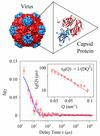issue contents
November 2022 issue

Cover illustration: Dynamics of bio-macromolecular colloidal suspension can occur simultaneously on telescopic length scales (top left) and are quantifiable via temporal decorrelation of coherent X-ray scattering intensities, a technique known as XPCS. At APS 8-ID beamline, the scattered X-ray photons were collected by a 1024 × 512 pixel Rigaku XSPA-500k detector (right) using the 52 kHz frame rate `Zero Dead Time' mode, and diffusive dynamics of viruses as small as 30 nm in diameter were evaluated at a length scale commensurate with the virus size (bottom left). The spatiotemporal resolution of XPCS will improve by orders of magnitudes with even larger pixel-array and implementation of `Burst' mode at the ultra-brilliant fourth-generation synchrotron radiation sources (see Switalski, Fan, Li, Chu, Sarnello, Jemian, Li, Wang and Zhang, pages 1429–1435).
facility information
research papers
 access
access access
access access
access access
access access
access access
access access
access access
access access
access access
access access
access access
access access
access access
access access
accessResults from the first megahertz-repetition-rate X-ray scattering experiments at the Spectroscopy and Coherent Scattering (SCS) instrument of the European XFEL are presented.
 access
accessbeamlines
 access
accesscomputer programs
 access
access
 journal menu
journal menu







































